We have reviewed both the Jackery Solar Generator 240 and the Jackery Solar Generator 500, and both have been superb – but both miss a vital Type C PD port. Does the Jackery Solar Generator 1000 make for the perfect backup battery? Read on to find out.
Jackery has very kindly sent over the Jackery Solar Generator 1000, which is made up of the Jackery Portable Power Station Explorer 1000, Two Jackery SolarSaga 100 Solar Panels, and they also sent over a Jackery carry bag for the Explorer 1000.
With a number of people turning to tenting and camping at galas, the Jackery 1000 provides power for not only your camera equipment but your laptop, lighting and more.
Jackery Portable Power Station Explorer 1000
The main part of this review looks at the Jackery Portable Power Station Explorer 1000, which has a 1002wh battery. The 2 Solar Panels are identical to our previous reviews, great for if you are looking to upgrade from a Solar Generator 240 or 500.
On the front of the Jackery 1000, you will find some differences and some similarities to the smaller models. There are 7 ways to charge devices, with the added flexibility of different ports.
There are 2 USB ports, one quick charge, up from the previous 2.4amp ports, there are also 2x USB Type C ports, which support 18w Power Delivery, great for charging laptops on the go.
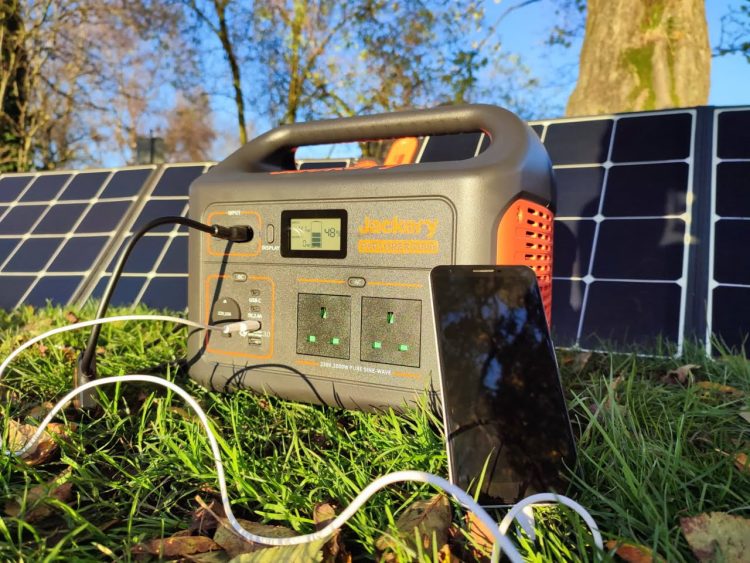
Besides the higher rated USB ports, you also get the 12v car plug as found on the other two Explorer power stations, and not one, but two 230v Pure Sine Wave plugs. Pure Sine Wave means it will be compatible with all devices (subject to power requirements of course). Some cheaper inverters provide a Modified Sine Wave output, which can be less kind to devices, making them run hotter and potentially wear out quicker.
The Power Station can provide up to 1000W at any one point, with a surge feature of up to 2000w, which is double the amount of power that is available on the Power Station 500, and 5 times as much power availability when compared to the Explorer 240.
The larger sized battery and increased wattage means that not only can you charge devices for longer, you can also plug in higher-powered devices.
Weighing nearly 10kgs, this is obviously heavier to carry, but if it is sat in the back of your car, then it is still a relatively small package, measuring 32cm x 22cm x 23cm.
The Power Station Explorer 1000 is available from Amazon for £1099.99 and you can purchase it by clicking here – at the time of writing, there is also a 5% off voucher available via Amazon.
If we have a closer look at the connections, you will see several different options available:
-

Credit: RailAdvent DC Input to charge the device alongside an Anderson Input to allow you to charge the device with 2 SolarSaga Panels (adapter included). The great thing is that if you only have one solar panel, it doesn’t matter as you can plug just one in. Charging can be via the Solar Panels, Car Charging or via a mains adapter.
- The Type C Ports provide power delivery up to 18w
- There is one USB Type A that provides 5v, 2.4amps and another USB port that provides Qualcomm Quick Charge standards.
- Two 230v Pure Sine-Wave AC UK plug socket
You can see how much power the device is outputting through the back-lit display, which also shows input power and battery percentage remaining.
As seen on the rest of the Jackery range, the Power Station Explorer 1000 supports pass-through charging, which means it can charge devices whilst being charged itself. This is especially useful when used in conjunction with the Solar Panel.
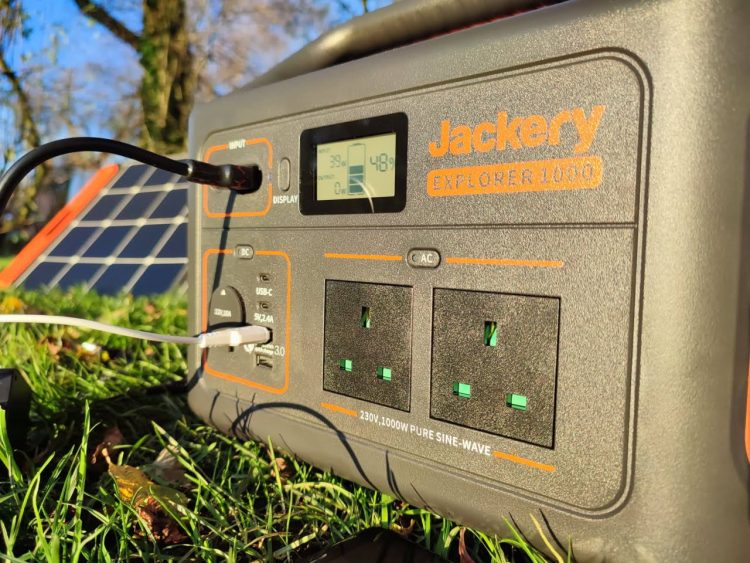
Each output has its own on/off switch, allowing you to choose which ports are being provided with power. The unit is also fitted with an LED torchlight.

What else can the Jackery supply power too? Well, apart from camera equipment, the Jackery is perfect for:
- Outdoor lighting
- Wheelchair charging on the go
- Off grid accessories like a fridge or electric hob
- Power tool batteries
- Multiple laptops and computers
In our testing, charging the device from 0 to 100% matched Jackery’s advertised charging of around 7 hours when using AC power. Solar charging really does depend on the weather unfortunately, so we couldn’t give a 0 – 100% but in our short testing time, we calculated that it would normally match Jackery’s advertised 8.5hours when using two solar panels on a sunny summers day.
Also in our testing, we used the Jackery 1000 in a variety of places and used it with a number of devices. Here is what we found:
- We used the Jackery 1000 at the recently held Pendle Forest Model Railway Society’s Model Railway Exhibition where, whilst plugs were available to some stands, our stand didn’t have an easy to reach plug. So instead, we used the Jackery 1000 to power a laptop on mains, a tablet to show previews of our DVDs, a Square card terminal and keep our phones charged up, along with a WiFi point. We didnt have to charge the Jackery at any point over the two days that the exhibition was held, and we could have gone on for a number of days had it have been a longer exhibition.
- An Asus 14 laptop recognised power was being taken but at 18W warned us that it would only slow charge the laptop’s battery
- A Microsoft Surface Go 2 also recognised the 18W PD input and charged well, with the Surface charging 20% in half an hour, the Jackery didn’t discharge by 1%.
- We watched TV for an hour and the Jackery went down between 1 and 2%
- We charged a caravan, which charged its own battery and powered the fridge lights and a TV for an hour, and the Jackery dipped by around 10-15%
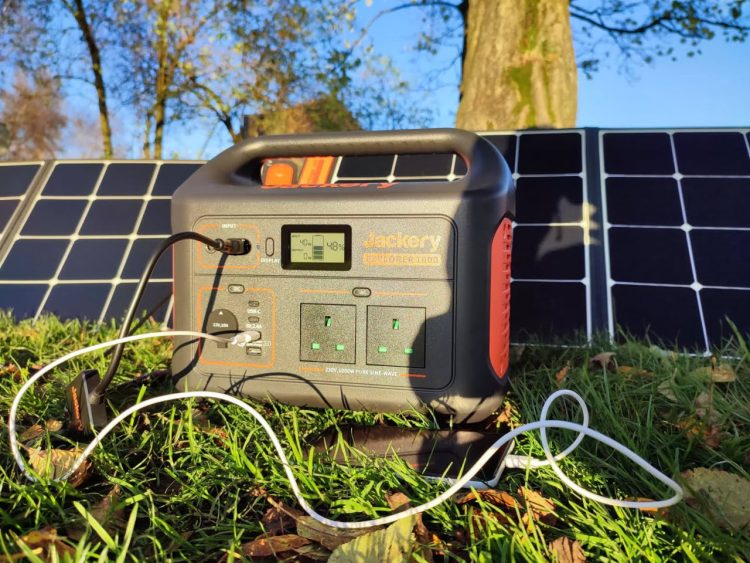
The Power Station Explorer 1000 is available from Amazon for £1099.99 and you can purchase it by clicking here – at the time of writing, there is also a 5% off voucher available via Amazon.
Jackery SolarSaga 100 Portable Solar Panel
The portable SolarSaga 100 Solar Panel works superbly when used in conjunction with the Power Station Explorer 1000, but can also be used as a standalone device.
The Solar Panel is IP55 rated, meaning it is water-resistant but is not waterproof. The Panel weighs 4kgs and measures 54cm by 61cm when closed, and 54cm by 123cm when open. It includes two fold away legs so that the panel can be angled in the direction of the sun.
There’s also a bonus Type C and USB port in the wire pocket to allow you to charge other devices.
The Jackery SolarSaga 100 Solar Panel is available on Amazon for £259.99 but at the time of writing is available with £20 off. Click here to find out more information.
Connecting up the Solar Panel to the Power Station is simple enough, just a case of plugging in the cable. You can then use the adapter supplied with the Jackery 1000 to chain link two SolarSaga 100s to provide even more solar charging capacity.
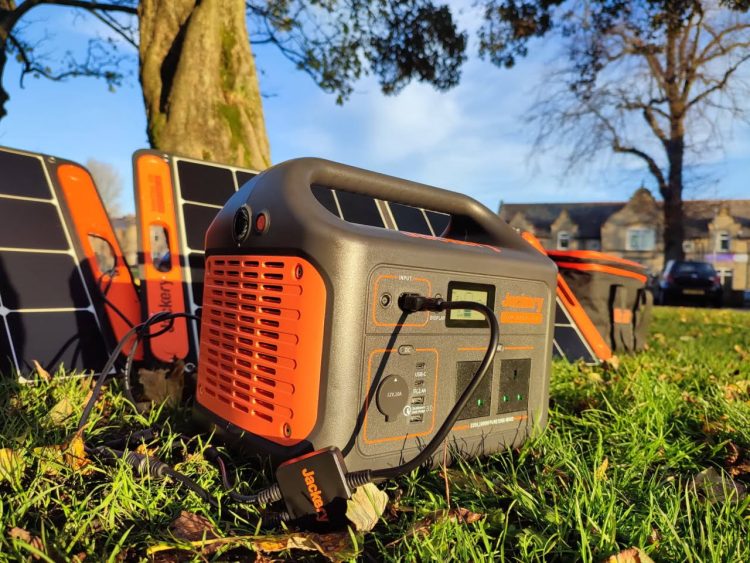
In our testing, the Solar Panel, when coupled up as a duo and connected to the Explorer 1000, provided up to 60W of power, and that was on a winter’s day as the sun was setting, very impressive indeed.
As mentioned before though, the Solar Panel 100 is best used with a Power Station to keep it topped up whilst the battery provides the power to your devices.
Materials on the Solar Panel are high quality and can be set up and put away quickly, with magnets making sure that the panel stays folded when put away.
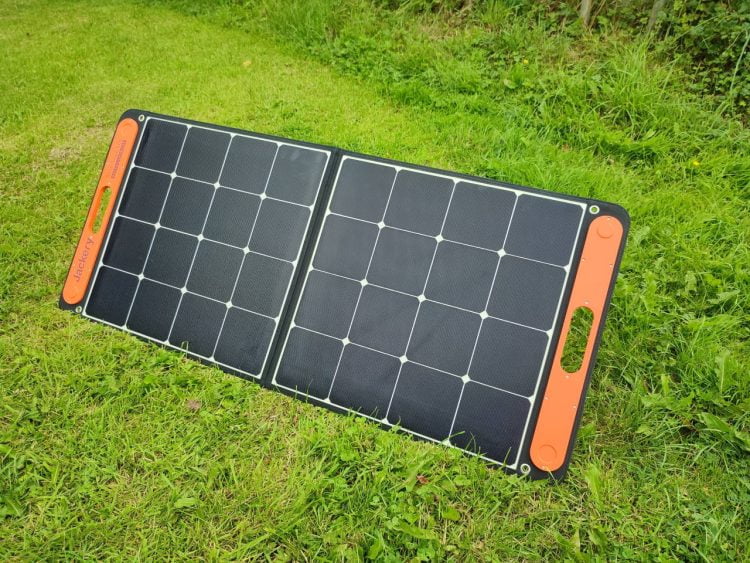
The Jackery SolarSaga 100 Solar Panel is available on Amazon for £259.99 but at the time of writing is available with £20 off. Click here to find out more information.
Jackery 1000 Carry Case
A premium accessory for the Jackery Explorer 1000, but one we feel is a great addition, is the carry case. With high-quality zips and handles, this is a great way to neatly carry your Jackery around with its charging cables and solar panel adapter.
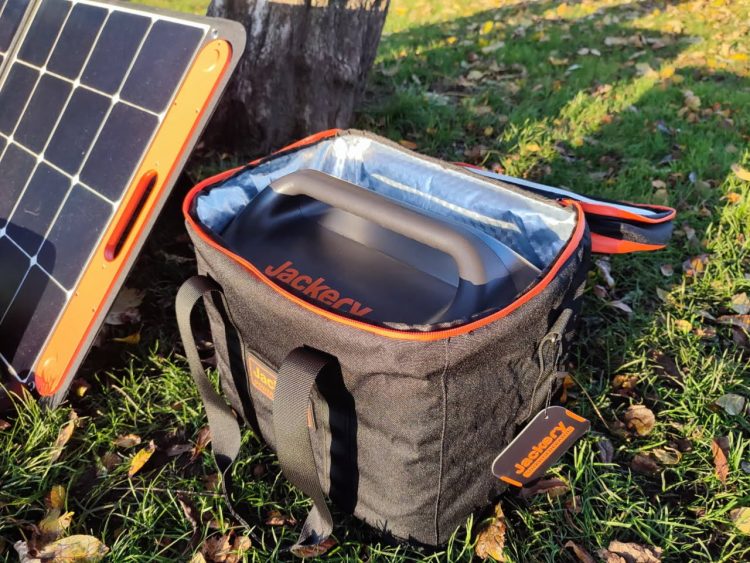
There are also carry cases available for the 240 and 500 variants.
The Explorer 1000 Carry Case is available for just £52.99 from Amazon with Prime next day delivery.
Conclusion
The Solar Generator 1000 really is the best that Jackery offers, if you are in need of a high powered battery to keep your devices going, this is it. Whilst a touch on the expensive side at over £1000, you do get a lot of battery for your money, and with the 7 ports available, it saves you having to buy spare batteries for video cameras, drones, photo cameras, laptops, which all add up as they are getting more expensive.
If you have ever been in a situation where your device has a flat battery that needs charging or you have a mains powered device that you would like to use away from a power socket, then these are the products for you.
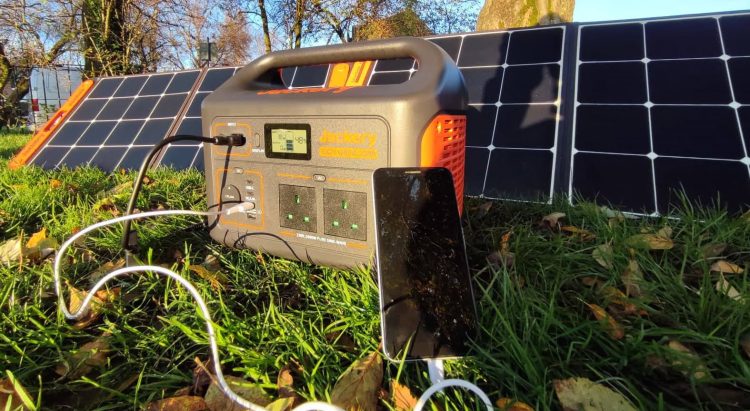
This 1000 variant adds what we have been looking for in the Power Delivery Type C ports to power laptops and phones quicker. Whilst in the future we may want PD60, the PD18 does provide enough power to charge “on the go” laptops, and does provide enough power to at least slow charge a bigger laptop.
Amazon Links to all products:
-
Jackery SolarSaga 100W Portable Solar Panel (Note: you will need 2 of these if wanting to team them up to charge the 1000)
- Jackery Power Station Explorer 1000 Carry Case
A big thank you to Jackery for sending both the Solar Panels, Carry Case, and Power Station Explorer 1000 to RailAdvent for us to review.


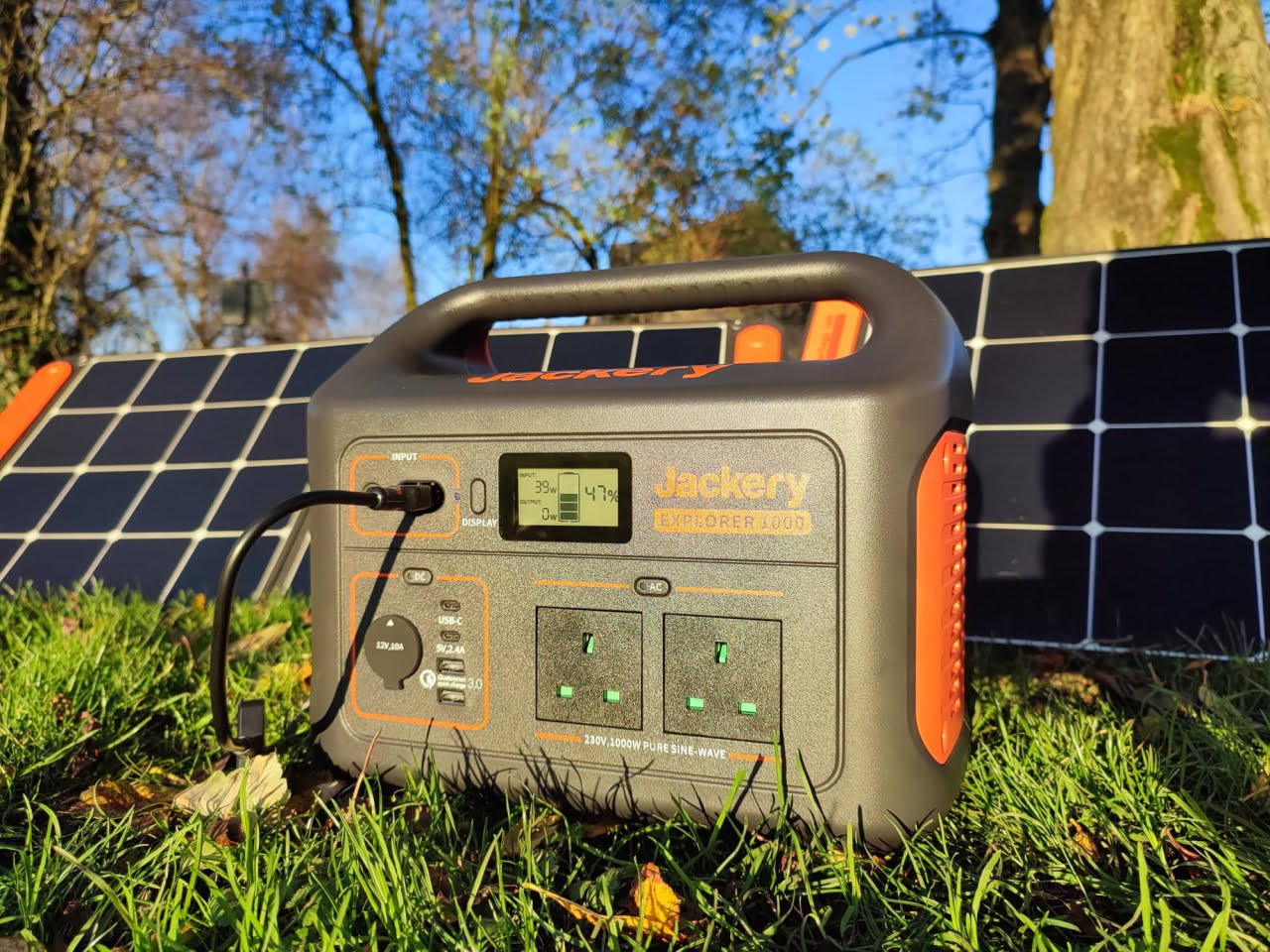



Responses